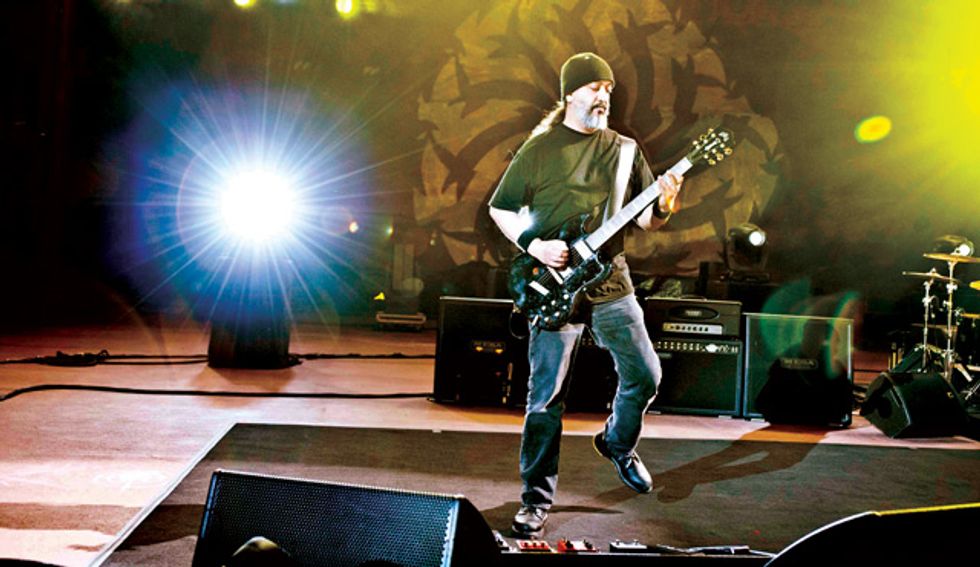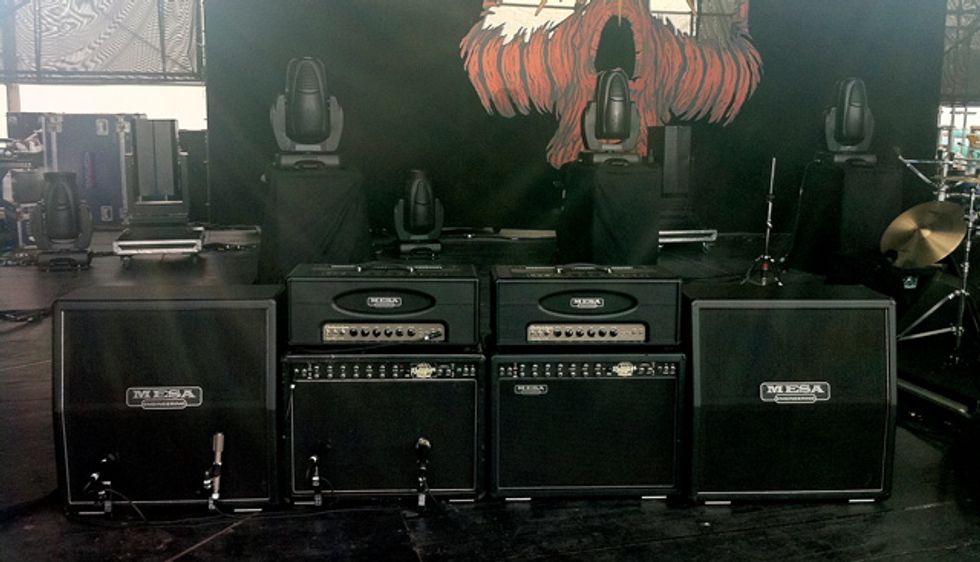Kim Thayil, the dropped-tuning lord of heavy grunge, walks us through the thickets of distortion, swirling psychedelic vortexes, and eastern-flavored motifs on Soundgarden''s epic return to form, King Animal.
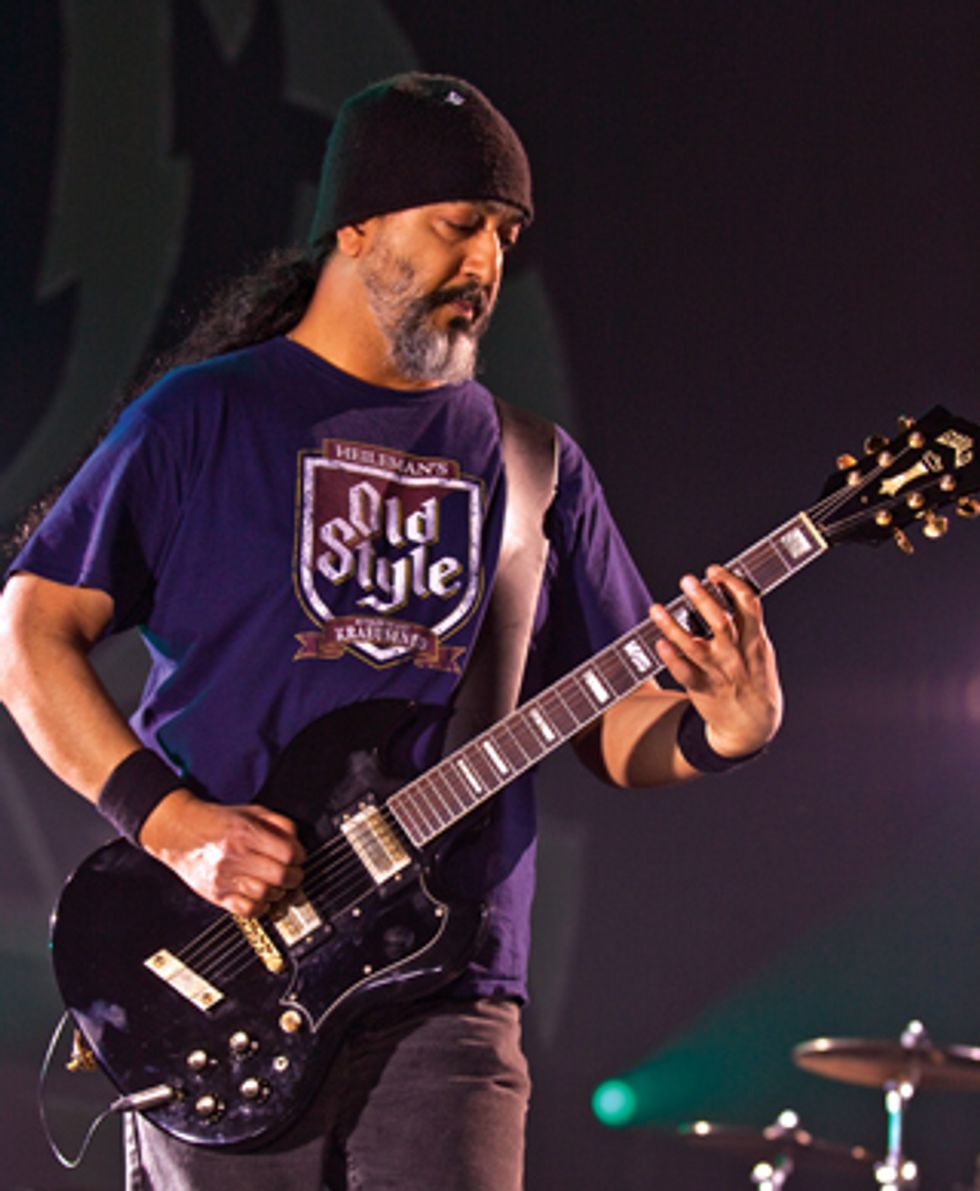
Photo by Chris Kies
“I’ve been away for too long” wails Chris Cornell on the opening track of King Animal—the first album of all-new Soundgarden material since 1996’s Down on the Upside. Yes, you have—welcome back, guys. It’s been so long that even Axl Rose had probably grown impatient.
Soundgarden solidified its grunge-fueled ’90s legacy on bassist Ben Shepherd and drummer Matt Cameron’s locomotive rhythm section and Cornell’s iconic howl, which placed him alongside Kurt Cobain, Eddie Vedder, and Layne Staley on grunge’s Mt. Rushmore. But the linchpin that held everything together and gave it color and depth was guitarist Kim Thayil’s chameleonic playing, which is equal parts ominous, Tony Iommi-style riffing, psychedelically swirling rhythms, and droning, Indian-flavored soloing.
“We got together and jammed—we just let the music dictate to us before committing to or planning anything,” says Thayil of the long-awaited reunion. “If it still wasn’t there, I can honestly say this album wouldn’t have happened. It is still there and I’m just happy to be back playing music with friends that I enjoy the intimate sharing of ideas with.”
Rather than rehashing old material like Van Halen did this year with their much-anticipated comeback album, or trying to model the material after past successes the way so many other reformed groups have, the grunge godfathers branched out in the way longtime fans hoped they would—and in a way decidedly not foreshadowed by the uncharacteristically slick and mainstream-feeling “Live to Rise” theme they provided for The Avengers earlier this year. Examples of that experimentalism include Thayil’s mandolin solo and Pink Floyd-style wah trickery in “A Thousand Days Before.” Futher, both that track and “Black Saturday” also incorporate a Faith No More-style horn arrangement.
“I’m still an angry dude,” laughs Thayil, “I’m just older. I still push the band to be heavy and dark—that’s always been my role.”
New musical twists aside, Soundgarden is as complex as ever. King Animal represents the best elements of Soundgarden’s past, including the slow-motion, train-wreck grinder of “Rowing” (which is reminiscent of “4th of July”), the cruising-and-bruising rawness of “Been Away Too Long” (which carries echoes of “Spoonman”), and the alluringly creepy-crawly feel of “Bones of Birds” (think “Black Hole Sun”).
PG recently talked with Thayil about his unwavering love for Guild S-100s, how he sets up his chorus pedals, and why you should never call him a “lead guitarist.”
How was recording different this
time than in the ’80s and ’90s?
Well, we didn’t have predetermined
deadlines set by the
record company—that was great.
I originally thought we’d have
the bulk of this done by the
summer of 2011 [laughs], but
once we started rolling and felt
that inertia of the music coming
together, one of us would have
to head out for a tour, or Adam
[Kasper, producer] would end
up having someone else lined up
for the studio. I think the only
issue this time around was when
we’d reconvene and jump back
into an unfinished part or song
from the previous session.
You once said you brought
in your couch to be more
comfortable during the
Superunknown recording sessions.
Did you do anything
to help you concentrate and
execute in the studio for this
album?
[Laughs] No, no … I never
brought my own couch in—my
girlfriend would’ve killed me.
What happened was that, in the
main recording room, they set
up a standing lamp and a couch
from the lounge in the studio.
The room was so big, with high
ceilings and fluorescent lights,
and I just hated it because it felt
like being in a dentist’s office.
One thing I’ve always done
since that recording was dim
the lights, because I prefer the
evening feel that a darker room
presents. When the lights are
up, it’s like you’re doing work
in an office, but when it’s more
relaxed and a bit darker, I feel
more relaxed and creative in
that sort of intimate setting.
You’ve played Guild S-100s
since the early days. Did you
mainly use S-100s in the studio
this time around?
Yes, but I also used a Guild
S-300. A few years back, I
picked up a few late-’70s S-300s
that came with DiMarzio Super
Distortion and PAF humbuckers.
What I like about these
particular S-300s is that they
sound even louder and have a
more defined crunch to them.
Ben and Chris even commented
during the studio sessions that
they like them a lot because
they cut through really well and
have beef and body. Normally,
I’ll use an S-300 live when I’m
the only guitarist for songs like
“Outshined.”
I used some Teles on the new album here and there, for when I play in the open C–G–C–G–G–E tuning featured in King Animal’s “A Thousand Days Before.” I played my Firebird quite a bit on King Animal, when I’m playing in the E–E–B–B–B–B tuning used on “Down on the Upside” and “My Wave.” For most of the dropped-D stuff, I use my S-100s. One of the surprises of the recording was our producer’s guitar, this Gibson Trini Lopez signature model, which was great for the clear, hollow, bell-like tones used for layering. I think the biggest thing for me—and the reason I need to get an ES-335 as soon as possible—is that the neck is so thin and fast with low action, and it has plenty of clarity and resonance.
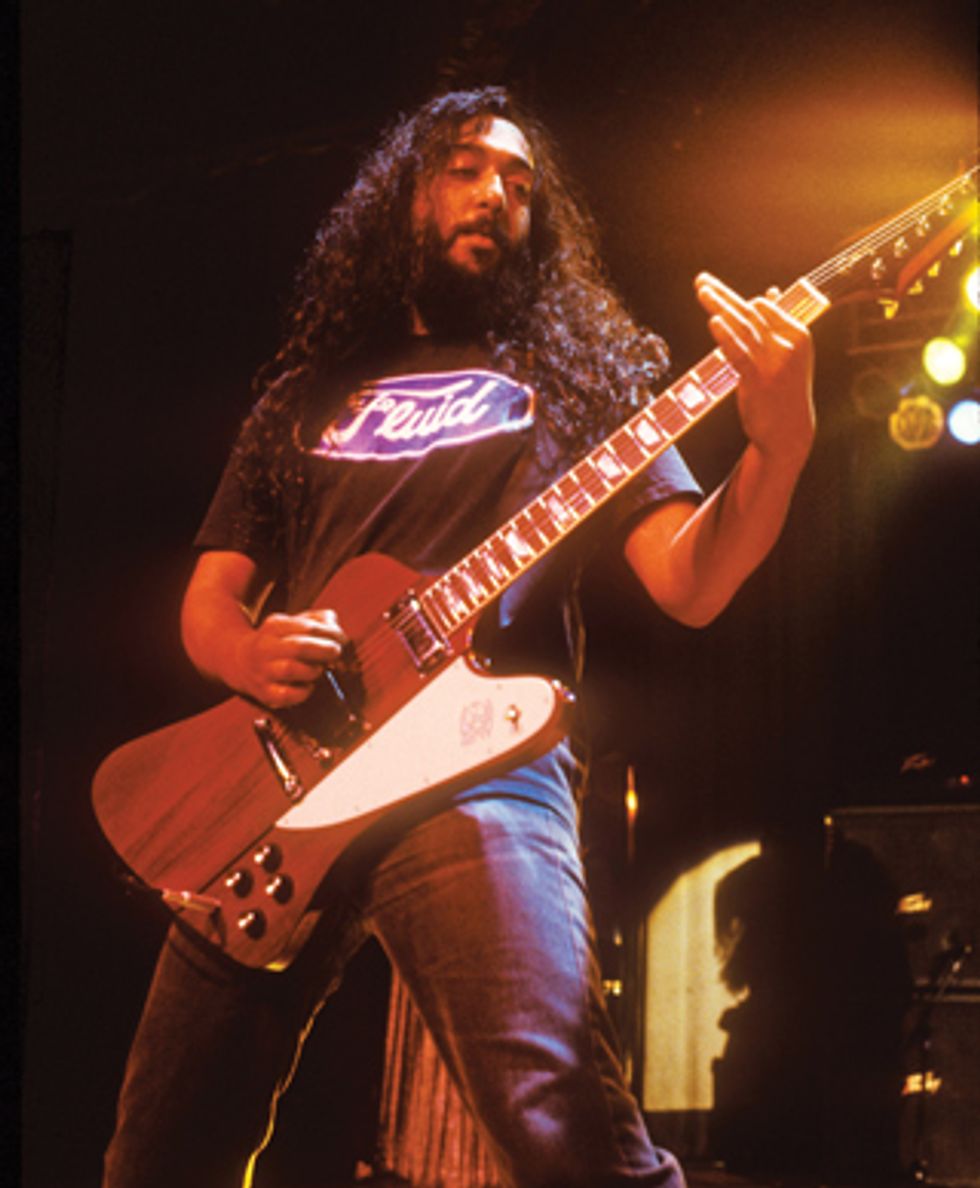
Kim Thayil of Soundgarden plays a Gibson Firebird at the Hollywood Palladium in October of 1991. Photo by Marty Temme
What did you initially like
about the playability and tone
of S-100s, compared to the SGs
they’re obviously based on—
and are those the same reasons
you still mainly use them?
The neck is faster than the
standard SG necks. Secondly,
those S-100s were affordable
[laughs]… I was 18 or so
and bought it used in 1978
for about $200. But once I
really started to play that first
S-100, I realized how well it
played with low action. The
SG neck was thicker and
the fretboard seemed wider,
and my hands couldn’t really
navigate that as easily as the
S-100. I really like the stock
Guild pickups—I have all the
original Guild pickups in my
S-100s—because they produce
a hot, loud, rambunctious
tone, which I love! Plus, the
stock tuning pegs on the Guild
S-100s are Grovers and they
have the perfect ratio and really
take a lot of force to get out
of tune.
What amps did you use primarily
on the new album?
I mainly went with the stuff
I’ve been using live—Mesa/
Boogie Electra Dyne heads and
Tremoverb 2x12 combos. I
really paid less attention to the
gear this time around, because
I knew that the Mesa/Boogie
stuff was solid and has worked
for me. Other amps that I
plugged into during the sessions
were Matt’s ’60s Vox AC30,
Ben’s ’50s Fender Champ, and
Adam’s Ampeg VT-22, Savage
Audio Rohr 15 combo, Fender
Vibroverb, and Fender Pro Jr.
The Tremoverb was around in
the ’90s, but the Electra Dyne
is only a few years old. How
did you get hooked on that?
Our drum tech, Neil Hundt,
who was my guitar tech for
Lollapalooza 2010, happened
to have an Electra Dyne
head with a 4x12 when we
went to rehearse. When I got
there, Matt brought a Mesa/
Boogie Tremoverb combo
and Neil had one, too. I just
really liked how it sounded
and it felt almost instantly
like Soundgarden. What I
instantly noticed about the
Electra Dyne was how loud
and versatile it was. I’m really
able to have an organic, full,
pushed-gain tone that I can
back off with my volume knob
for the rhythm parts, like
during “Fell on Black Days”
or during the intro to “Black
Hole Sun.” I don’t really like
a quiet, thin, clean tone—it
might work when you have a
Tele and you’re playing country
or chicken-pickin’. I like it to
be thick, warm, and loud.
What is it you like about
how the Electra Dyne and
Tremoverb amps complement
each other?
Both amps have 6L6 power
tubes and are on all the time
and about equal in level—one
isn’t really dominant over the
other. The Electra Dyne provides
the top and the bottom of
the tone, while the Tremoverb
sort of fills the middle with
its focused, driven sound that
provides my tone’s bite. The
Tremoverb might get dialed
a little dirtier while leaving
more headroom on the Electra
Dyne set in the 45-watt mode.
The preamp level is about 2
o’clock and the master around
9 o’clock. I use both the red
and orange channels on the
Tremoverb set to vintage high
gain and blues.
“A Thousand Days Before”
has a “Burden in My Hands”-
type vibe, with tinges of
Indian sitar-like tones. How
did you get those?
I remember playing around with
a sitar during the Badmotorfinger
period, and I heard Metallica use
a sitar on Metallica in ’91, but
we opted not to use the electric
sitar because it sound a little
too gimmicky for us. The key
to that sound for what we do is
an open slide tuning, C–G–C–
G–G–E. That’s what facilitates
that droning effect. Before we
finished the song, its working
title was “Country Eastern,”
because we incorporated some
chicken-pickin’ playing, too. But
with that open tuning and the
S-100 and the amp’s tonal setup,
it gave it a very distinct Eastern
vibe. Underneath the main
guitar track there is an electric
tambura that Adam is playing,
which creates an odd groaning
sound. It works for that song
and how low-key it is, but I just
never want to overdo anything
like that … I want to avoid the
cheesiness. I also play slide guitar
on the Tele, and I doubled
the main guitar part with a
mandolin in the second and
third verse and at the beginning
of the guitar solo before it goes
into a doubled electric guitar
part that I play, technique-wise,
like slide and backwards—but
it’s not backwards [laughs]. I just
play as if I’m listening to a backward
guitar.
Thayil rocking out with his favorite Guild S-100 while being flanked by his Mesa/Boogie Electra Dyne and Tremoverb
amp setup during a performance at Red Rocks Amphitheatre in Morrison, Colorado, on July 18, 2011.
How did that idea come about?
The solo needed to go with the
Eastern vibe we play in the rest
of the song, so when I doubled
the guitar with that tuning it created
a bagpipe effect. I was blown
away because it’s a sound I love
from two of my favorite Velvet
Underground songs—“What
Goes On” and “Rock and Roll.”
I just kind of stumbled into it
with the tuning and mimicking
the background playing. We had
the mandolin soloing throughout
that whole section, but once we
got this cool, doubled-bagpipe
sound we decided to just have it
in the solo’s intro—it works like a
butterfly opening its wings going
from the single mandolin to the
two distorted guitars in that open
tuning playing off each other.
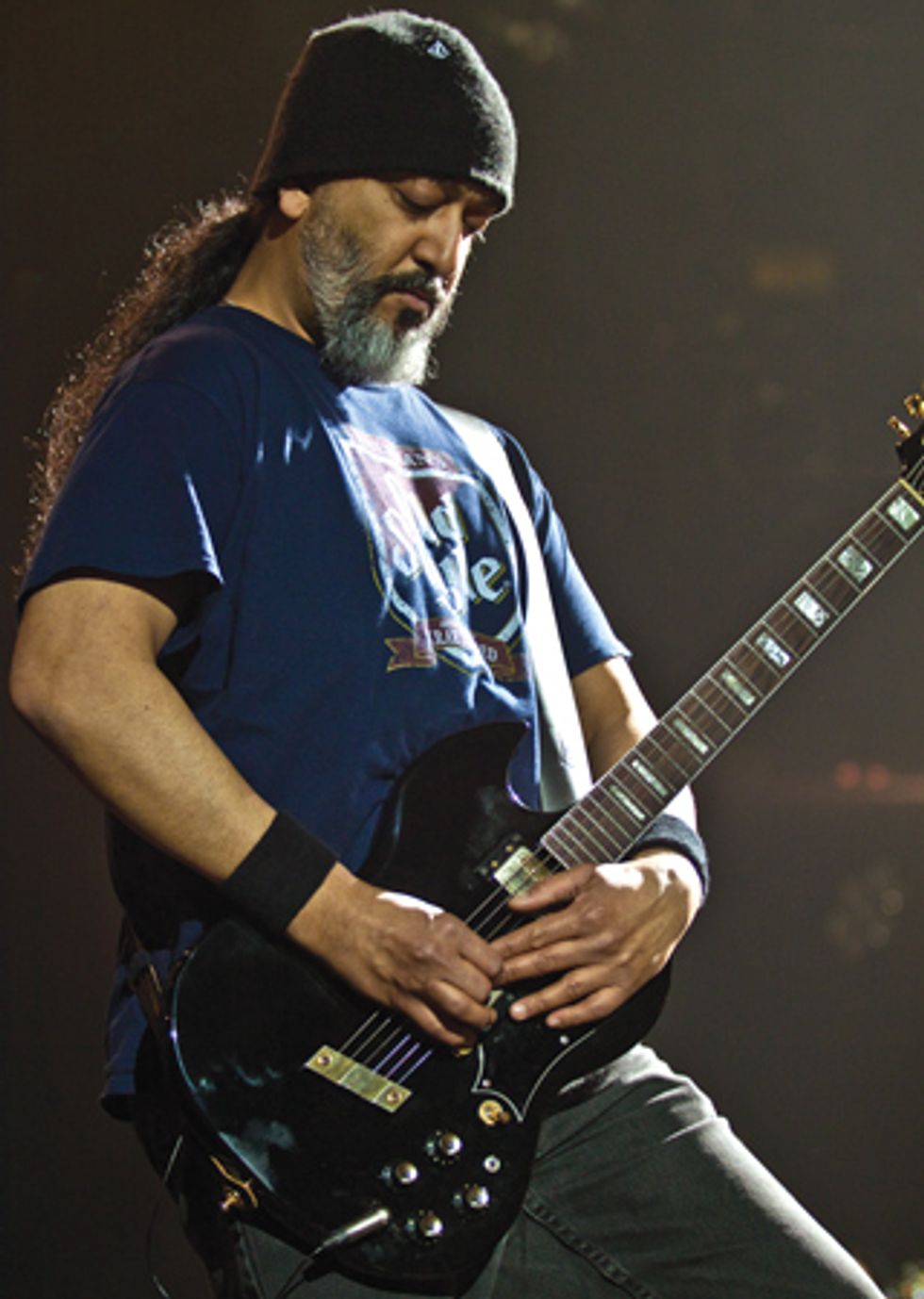
One of Kim Thayil’s favorite guitar pastimes is creating chaos. He gets inventive during “Spoonman” at the UIC Pavilion in Chicago in July 2011. Photo by Chris Kies
You’ve always had a knack for
ambient, psychedelic textures.
Back when we started in the
’80s—when it was me Chris
and Hiro [Yamamoto, original
Soundgarden bassist]—we
would call that sort of thing
“color guitar.” Those are the
parts that would augment a section—
we were particularly good
with that because we could hear
and picture things that were
either missing or could really
bolster a song. We’d be sitting
around listening or jamming
and one of us would be, like, “I
want to do this feedback thing
right here,” or “in this section
we could do this really heavy,
three-note arpeggio into the
verse.” I used to get so annoyed
when I’d see “Kim Thayil –
Lead Guitar” because I’d see
a damn lead guitarist in every
rock record and so much of
what we do is beyond chords
and notes—it’s about having a
feel for a different instrument
or different application of a
traditional guitar. I enjoy “color
guitar” as much as I do soloing.
In the last 30 seconds of “By
Crooked Steps,” the solo
guitar wanders into a tonal
frontier that sounds a little
like Tom Morello with his
DigiTech Whammy. How did
you get that trippy, atmospheric
effect?
I’m using the Trini Lopez. It has
a lot of room to play the strings
behind the bridge, and when
you do that while bending notes
on the fretboard you get this
really weird effect. If I pick a
note and rub the strings with
my thumb or the side of my
hand, I get this ringing, buzzing
sub-harmonic. What you hear at
the end of the song is me rubbing
the strings to get the ringing
effect, adding a long delay,
and then cranking the high
end on my amp to push it to a
real shrill squeal—like a dentist
drill—on top of me picking
some intermittent notes.
You’ve been using ethereal,
ghostly feedback parts as far
back as “Loud Love” [from
1989’s Louder Than Love],
and you use them this time
around on “By Crooked
Steps” and “Non-State Actor.”
What’s the trick to applying
feedback in a musical way?
You’ve got to have it loud enough
to feed back, but you can’t have
you can’t control it. I’ve found
that a bigger speaker, like a 15",
produces a nice, low-level hum.
We’ve always embraced feedback,
starting in the early days of the
band—I used to record with
Hiro’s backup Ampeg B-15 bass
amp. I would dial out most of
the low end and put in quite a
bit of high end with an Ibanez
Tube Screamer and a chorus
to get a brighter, more guitar-y
sound. When we jammed with
other people or they would show
us stuff, so many things were
undesirable, considered noise, and
deemed incorrect. But we keep
the incorrect things—they sound
heavy, chaotic, powerful, and wild.
I always have and always will push
the band in that direction.
Thayil plugs into Mesa/Boogie Electra Dyne heads, Tremoverb 2x12 combos, and Stiletto 4x12 cabs. Photo by
Josh Evans (Kim Thayil’s guitar tech)
“Blood on the Valley Floor”
and “Been Away Too Long”
have some of the album’s
chunkiest tones. Did you use an
overdrive or distortion pedal in
addition to the gain from your
amps, or did you get all your
dirt from the amps?
Heaviness with us never came
from just cranking the volume
and tuning the strings down.
We helped popularize the idea
of using alternative, lower tunings,
but we have this darkness,
this doom element in our songs
by way of the vocals, guitar,
and melody interplaying—it’s
those colored parts that kind of
change the chord and structure
just enough by combining major
chords with underlying, subdued
arpeggios, and ghostly ringing in
the background, coupled with
the dominant chords and vocal
patterns. We still enjoy the visceral
power of cranking things to
11, but the complex, cascading,
complementary dark layers you
can create are often heavier than
the visceral approach. Another
part of that is the odd time
signatures, like 7/4 or 5/4, that
are in some of our songs. I think
anything different or mysterious
can be channeled into heavy—
abnormality is a key.
That being said, the angry kid inside still loves getting loud. For “Blood on the Valley Floor” and “Been Away Too Long,” I might’ve used a T-Rex Dr. Swamp double distortion or the MXR CAE MC-402 boost/distortion during the solos. I mainly got my gain from overdriving the amps. My tech would be in the room changing the amps’ controls with gun-range ear protectors while I played and settled on the tones in the control room [laughs].
Many players think thick
tones require heavy strings
and picks, but you tend to use
lighter-gauge strings and picks.
In the early days, I used .008s
because I tended to play a lot of
hammer-ons, pull-offs, and really
long, exaggerated string bends.
But as I played more frequently,
I went up to .009s because the
.008s just got too loose and I was
playing more and more. Now that
we’ve been touring a lot again and
recording, I’ve gone up to .010s
after playing the .009s for a few
months, because my arm and
wrist got into shape. But when
you tune down to C–G–C–G–
G–E or E–E–B–B–B–E, the
lighter strings bend out of tune
more when you’re playing the
chord. Even if the tuners are keeping
them in tune when you hit the
open string, the chords are always
a bit more flimsy, so the heavier
strings give me more resistance.
And for songs like “Rusty Cage,”
I’ll have a guitar set with .010s but
with a heavier low-E string.
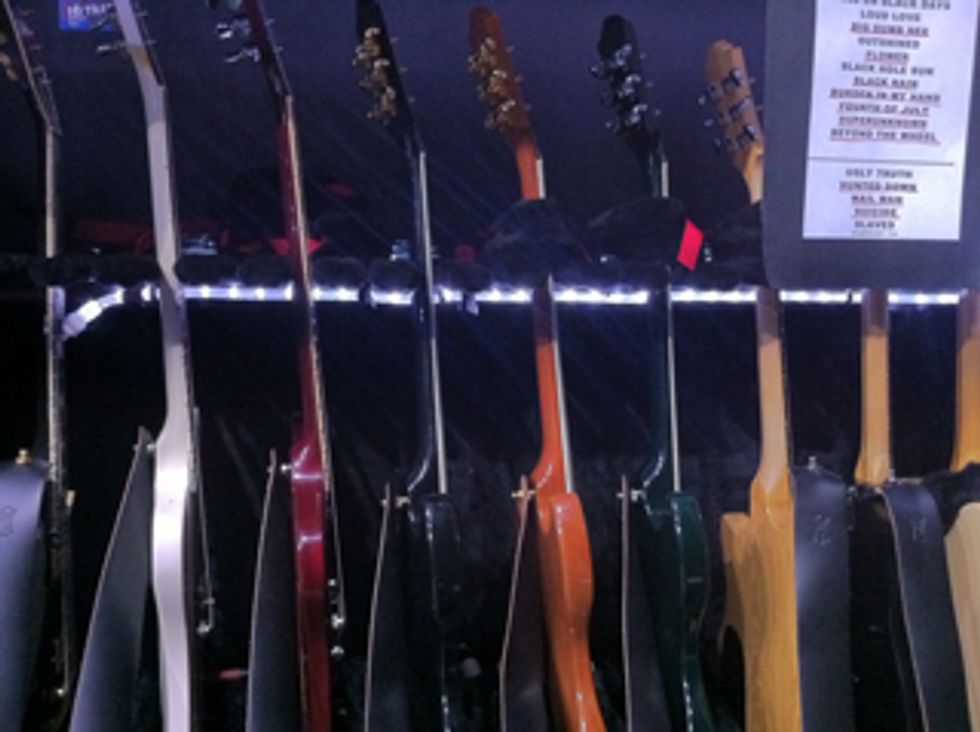
Photo by Josh Evans (Kim Thayil’s guitar tech)
What is it that draws you to
altered tunings?
It’s those sympathetic notes—
like in dropped-D you get
this beautiful droning effect
that’s in “Nothing to Say,”
where we bounce off the main
riff and the high D melody is
ringing open to get this spiraling,
psychedelic chaos. I play
similar droning parts this time
with “Worse Dreams” and “A
Thousand Days Before.” We’ve
always tried to capture a heaviness
and aggressiveness in ways
other than your standard guitar-volume
max-out.
Did you use the Hughes &
Kettner Rotosphere that so
famously defined your sound
on “Black Hole Sun” at all on
this album?
I still have that same Rotosphere
on my pedalboard, and I alternate
between the fast setting for
the verses and the slow setting for
the choruses. Other songs I use
it on are “Hunted Down” and
“Let Me Drown.” I use the high
rotor speed to emulate the Leslie
147 used on the record. For King
Animal, we would occasionally
use the trim pots to speed up the
modulation to more of a stun-gun
effect and put that through
an Electro-Harmonix Micro
POG—like in the guitar melodies
of “Been Away Too Long.”
Other applications on King
Animal are the glassy shimmer in
“Bones of Birds” and the swirl of
“Halfway There.”
I think I’ll be retiring the Rotosphere from the road soon, though. [Ed. note: Thayil’s tech, Josh Evans, explains that the Rotosphere will still be in use but will soon be located offstage in a rack, with Thayil accessing its two different speed settings onstage with a Radial BigShot SW2 Slingshot.] I also used my old Ibanez CS9 Stereo Chorus because it has this weird dark character I’ve only heard in that specific stompbox— it was the same pedal I recorded “Nothing to Say” and “Beyond the Wheel.”
A lot of players hate chorusing
because they think it sounds
cheesy or overproduced, but
the way you use it avoids that.
What do you like so much
about the effect?
For me and my playing style,
it’s perfect for harmonics, feedback,
and arpeggiated guitar
riffs, which have been big part
of my playing since Screaming
Life. That’s why I love and
abuse choruses so much. The
chorus plays well with all those
elements and gives a shimmer
and ring to my tone during the
single-note playing of arpeggios.
Plus, it gives a fuller, lusher
whoosh sound, too. And when
we play live and you have the
big speakers and you get the
feedback humming and you
add the chorus, it sounds like a
UFO landing [laughs].
“Bones of the Birds” also has
very complex, psychedelic
tones—especially when you
listen to it with headphones.
Can you describe the signal
chain you used to create that
soundscape?
During that song’s chorus—it’s
my favorite part—I’m hitting
harmonics in this ascending
melody. I’m playing that
through a stereo chorus, emphasizing
the harmonics alongside
the actual picked notes.
Kim Thayil's Gear
Guitars
’90s Guild S-100s, late-’70s Guild S-300s with DiMarzio
Super Distortion and PAF pickups, Gibson Firebird,
American Standard Telecaster
Amps
Two Mesa/Boogie Electra Dyne heads (set to 45 watts), two
Mesa/Boogie Tremoverb 2x12 combos, two Mesa/Boogie
Stiletto 4x12 cabs
Effects
Electro-Harmonix Micro POG, Dunlop/Custom Audio
Electronics MC-402 Boost/Overdrive, MXR M-151
Doubleshot Distortion, Dunlop/CAE MC-404 Wah,
Dunlop Rotovibe, T-Rex Reptile, T-Rex Dr. Swamp, Ibanez
CS9 Chorus, Hughes & Kettner Rotosphere
Strings, Picks, and Accessories
GHS Boomer .009-.046 and .011-.050 sets, Jim Dunlop .73 mm Nylon
picks, Boss TU-3 Tuner, Boss NS-2 Noise Suppressor, Lehle
P-Split High-Impedance Splitter, two Radial Engineering
BigShot SW2 Slingshot two-button universal remote switchers
(one for channel switching and varying gain in the Tremoverb,
and one for both engaging and alternating between slow and
fast Rotosphere settings)
What about the end, where it
sounds like birds?
That was a complete accident
that happened when I was fooling
around with my wah and delay
while playing with the volume
knob on my guitar. You bring up
the volume just enough to get
the squeal, and then you dial it
back and the delay really bounces
it around—like a bird cawing off
in the distance. Adam read that
Pink Floyd had done something
like that to get a similar bird-call
effect. It involved them using
a wah backwards—reverse the
input/output of your wah—
which makes it squeal quite a
bit, but you control that with a
volume pedal, and then you have
to time the delay just right and
it chirps off into the distance.
We recorded it a few times so it
sounds like a flock of birds, but
there are a few times where you
can tell it’s a guitar making the
noise [laughs]… I don’t mind
because, well, it is a guitar.
It seems that, while you love
gear that facilitates some of
your colorful tendencies, overall
you seem pretty disinterested
in seeking out the latest,
greatest gear.
Totally. When you’re younger,
you have to go to the store
and spend the money that you
worked all summer so you could
buy a new guitar or amp. You
knew exactly what you wanted
and needed—you studied viable
gear choices to pass the weeks
while saving up. Eventually, after
years of this and playing countless
pieces of gear—some perfect
for you, some you never want
to hear again [laughs]—you find
what works best for your band
or recording project. Knowing
what you don’t like or need is
half the battle with gear, but
you only find that out by playing
the stuff. We focus more on
the performance, song crafting,
and the creative elements within
the band. Sure, I like to tinker
around with sounds, noises,
and textures, but if it doesn’t
help build a better song, then
what’s the point? I’m not on a
first-name basis with my gear—I
know it’s surname, like Mesa/
Boogie or Peavey—but it never
has me over for dinner or anything
like that [laughs].
YouTube It
Dust off your flannel, prep your
stage-diving skills, and dial the
DeLorean for the early ’90s to
witness this hypnotically raw
performance of Soundgarden’s
“Jesus Christ Pose.”
Soundgarden’s official welcome
back party at Lollapalooza 2010
proved two things: Cornell’s
voice is still as fierce as ever,
and Thayil’s tone backs down to
no one.
The tar-dripping, swampy grinder
that is “Slaves and Bulldozers” is
quintessential Thayil—menacing,
down-tuned chords, deep string
bends, and a delay-minced wah
solo not to be missed.
